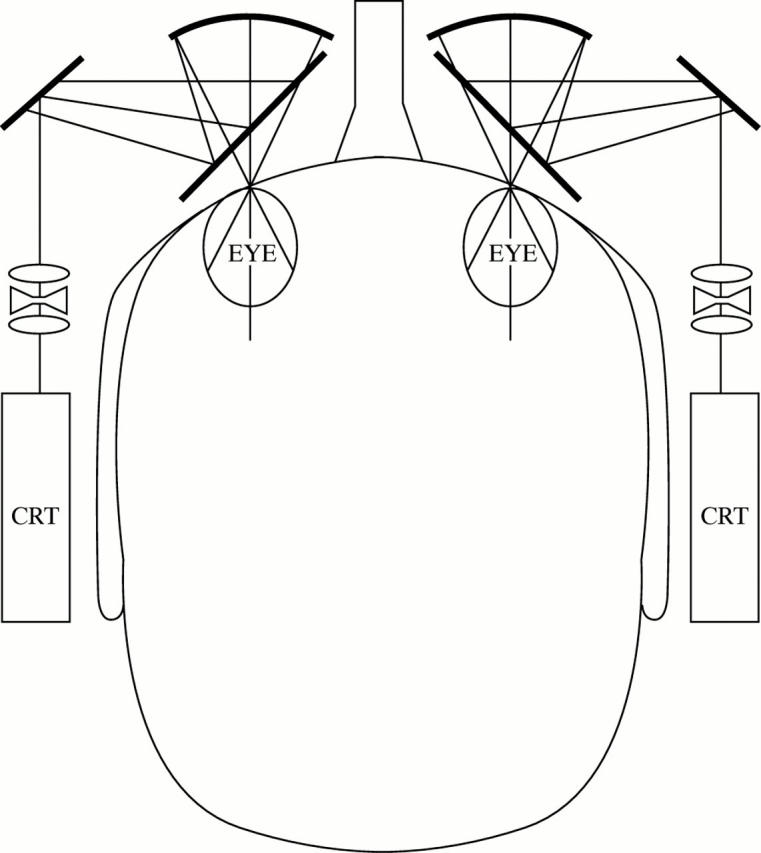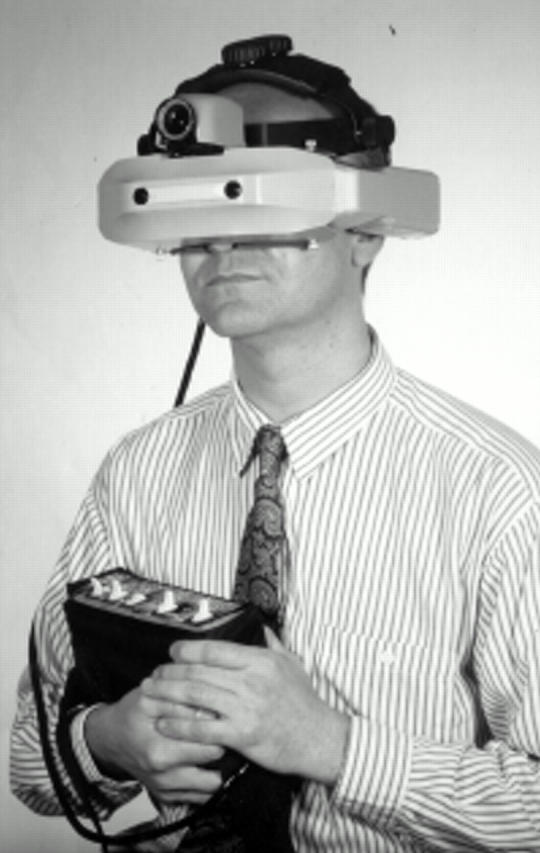Full Text
The Full Text of this article is available as a PDF (113.9 KB).
Figure 1 .

Schematic diagram of the LVIS. A magnified intermediate image of each cathode ray tube (CRT) screen is formed by an aspheric triplet lens system. Light from the temple arm CRT is directed by the folding mirrors to the 50/50 beam splitter in front of the eye. The curved mirror images the exit pupil of the optical system in the plane of the subject's pupil and displays a 50° × 40° image of the CRT screen. A refractive correction, if necessary, can be inserted between the CRT and the aspheric triplet (redrawn after Massof et al 15).
Figure 2 .

Photograph of the LVIS. The two monochrome charge coupled device cameras mounted in front of the eyes provide an unmagnified binocular field of view for orientation and the third centre mounted zoom camera provides variable magnification. The control unit can be worn as a "belt pack" and consists of a series of switches (for example, to enhance contrast, change contrast polarity, or "toggle" between orientation and zoom cameras). The function of the switches must be learnt, since these cannot be seen when the unit is worn.
Selected References
These references are in PubMed. This may not be the complete list of references from this article.
- Brabyn J. Problems to be overcome in high-tech devices for the visually impaired. Optom Vis Sci. 1992 Jan;69(1):42–45. doi: 10.1097/00006324-199201000-00006. [DOI] [PubMed] [Google Scholar]
- Demer J. L., Amjadi F. Dynamic visual acuity of normal subjects during vertical optotype and head motion. Invest Ophthalmol Vis Sci. 1993 May;34(6):1894–1906. [PubMed] [Google Scholar]
- Demer J. L., Porter F. I., Goldberg J., Jenkins H. A., Schmidt K. Dynamic visual acuity with telescopic spectacles: improvement with adaptation. Invest Ophthalmol Vis Sci. 1988 Jul;29(7):1184–1189. [PubMed] [Google Scholar]
- Den Brinker B. P., Beek P. J. Reading with magnifiers. Ergonomics. 1996 Oct;39(10):1231–1248. doi: 10.1080/00140139608964542. [DOI] [PubMed] [Google Scholar]
- Elliott D. B., Trukolo-Ilic M., Strong J. G., Pace R., Plotkin A., Bevers P. Demographic characteristics of the vision-disabled elderly. Invest Ophthalmol Vis Sci. 1997 Nov;38(12):2566–2575. [PubMed] [Google Scholar]
- Fowler C. Simplified closed circuit television magnifier for the partially sighted. Ophthalmic Physiol Opt. 1993 Jan;13(1):95–96. doi: 10.1111/j.1475-1313.1993.tb00432.x. [DOI] [PubMed] [Google Scholar]
- Goodrich G. L., Mehr E. B., Darling N. C. Parameters in the use of CCTV's and optical aids. Am J Optom Physiol Opt. 1980 Dec;57(12):881–892. doi: 10.1097/00006324-198012000-00002. [DOI] [PubMed] [Google Scholar]
- Goodrich G. L., Mehr E. B., Quillman R. D., Shaw H. K., Wiley J. K. Training and practice effects in performance with low-vision aids: a preliminary study. Am J Optom Physiol Opt. 1977 May;54(5):312–318. doi: 10.1097/00006324-197705000-00007. [DOI] [PubMed] [Google Scholar]
- Harper R., Doorduyn K., Reeves B., Slater L. Evaluating the outcomes of low vision rehabilitation. Ophthalmic Physiol Opt. 1999 Jan;19(1):3–11. doi: 10.1046/j.1475-1313.1999.00411.x. [DOI] [PubMed] [Google Scholar]
- Hayes T., Morrone M. C., Burr D. C. Recognition of positive and negative bandpass-filtered images. Perception. 1986;15(5):595–602. doi: 10.1068/p150595. [DOI] [PubMed] [Google Scholar]
- Humphry R. C., Thompson G. M. Low vision aids--evaluation in a general eye department. Trans Ophthalmol Soc U K. 1986;105(Pt 3):296–303. [PubMed] [Google Scholar]
- Lawton T. B. Improved reading performance using individualized compensation filters for observers with losses in central vision. Ophthalmology. 1989 Jan;96(1):115–126. doi: 10.1016/s0161-6420(89)32935-6. [DOI] [PubMed] [Google Scholar]
- Leat S. J., Fryer A., Rumney N. J. Outcome of low vision aid provision: the effectiveness of a low vision clinic. Optom Vis Sci. 1994 Mar;71(3):199–206. doi: 10.1097/00006324-199403000-00009. [DOI] [PubMed] [Google Scholar]
- Lewis H. T. Parameters of contact lens-spectacle telescopic systems and considerations in prescribing. Am J Optom Physiol Opt. 1986 May;63(5):387–391. doi: 10.1097/00006324-198605000-00012. [DOI] [PubMed] [Google Scholar]
- Massof R. W., Rickman D. L. Obstacles encountered in the development of the low vision enhancement system. Optom Vis Sci. 1992 Jan;69(1):32–41. doi: 10.1097/00006324-199201000-00005. [DOI] [PubMed] [Google Scholar]
- McIlwaine G. G., Bell J. A., Dutton G. N. Low vision aids--is our service cost effective? Eye (Lond) 1991;5(Pt 5):607–611. doi: 10.1038/eye.1991.105. [DOI] [PubMed] [Google Scholar]
- Peli E., Goldstein R. B., Young G. M., Trempe C. L., Buzney S. M. Image enhancement for the visually impaired. Simulations and experimental results. Invest Ophthalmol Vis Sci. 1991 Jul;32(8):2337–2350. [PubMed] [Google Scholar]
- Peli E. The visual effects of head-mounted display (HMD) are not distinguishable from those of desk-top computer display. Vision Res. 1998 Jun;38(13):2053–2066. doi: 10.1016/s0042-6989(97)00397-0. [DOI] [PubMed] [Google Scholar]
- Raasch T. W., Leat S. J., Kleinstein R. N., Bullimore M. A., Cutter G. R. Evaluating the value of low-vision services. J Am Optom Assoc. 1997 May;68(5):287–295. [PubMed] [Google Scholar]
- Rohrschneider K., Bruder I., Aust R., Blankenagel A. Anwendungen einer neuen optoelektronischen Sehhilfe für hochgradig Sehbehinderte (LVES). Klin Monbl Augenheilkd. 1997 Feb;210(2):105–110. doi: 10.1055/s-2008-1035025. [DOI] [PubMed] [Google Scholar]
- Shuttleworth G. N., Dunlop A., Collins J. K., James C. R. How effective is an integrated approach to low vision rehabilitation? Two year follow up results from south Devon. Br J Ophthalmol. 1995 Aug;79(8):719–723. doi: 10.1136/bjo.79.8.719. [DOI] [PMC free article] [PubMed] [Google Scholar]
- Watson G. R., De l'Aune W., Long S., Maino J., Stelmack J. Veterans' use of low vision devices for reading. Optom Vis Sci. 1997 May;74(5):260–265. doi: 10.1097/00006324-199705000-00020. [DOI] [PubMed] [Google Scholar]
- Watson G. R., De l'Aune W., Stelmack J., Maino J., Long S. National survey of the impact of low vision device use among veterans. Optom Vis Sci. 1997 May;74(5):249–259. doi: 10.1097/00006324-199705000-00019. [DOI] [PubMed] [Google Scholar]
- Wensveen J. M., Bedell H. E., Loshin D. S. Reading rates with artificial central scotomata with and without spatial remapping of print. Optom Vis Sci. 1995 Feb;72(2):100–114. doi: 10.1097/00006324-199502000-00009. [DOI] [PubMed] [Google Scholar]
- Whittaker S. G., Lovie-Kitchin J. Visual requirements for reading. Optom Vis Sci. 1993 Jan;70(1):54–65. doi: 10.1097/00006324-199301000-00010. [DOI] [PubMed] [Google Scholar]
- Wurm L. H., Legge G. E., Isenberg L. M., Luebker A. Color improves object recognition in normal and low vision. J Exp Psychol Hum Percept Perform. 1993 Aug;19(4):899–911. doi: 10.1037//0096-1523.19.4.899. [DOI] [PubMed] [Google Scholar]


